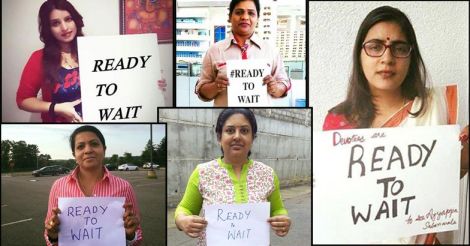After the Bombay High Court lifted the ban on women entering the Shani Shignapur temple and Haji Ali Dargah, the focus is now on the ancient Sabarimala temple in Kerala.
The hill shrine in Pathanamthitta district of Kerala has been in a legal tangle after a petition was filed in Supreme Court seeking revocation of a centuries-old tradition, which bans women aged between 10 and 50 from entering the temple.
India gets a fig leaf at the Olympics, from its much-abused daughters
While the apex court is yet to deliver its verdict, a section of women devotees in the state have set off a counter-campaign claiming they are ready to wait to reach the stipulated age to scale the hill and enter the temple.
The novel campaign, seen as a major setback to the women activists who seek to drum up support for their movement in the state, has already set the social media by storm with the hashtag #ReadyToWait trending on both Facebook and Twitter. #ReadyToWait is apparently a counter to the #RightToPray drive launched recently by a national TV channel.
The new campaign gathered momentum after a Facebook user Anjali George published a post on Saturday in which she sought to explain how "Sabarimala is not a gender issue".
"You cannot apply the semitic scale which reduces God to a human figure to pagan traditions that worship nature and its forces," she said in her post. Several women devotees have taken to Facebook and Twitter to urge the "western-funded feminists and Godless communists" to leave the customs of the native civilisation to the devotees of the temple.
Anjali writes: "Just like there is space for both theism and atheism in Sanatana dharma, there is also space for male or female worship or their exclusion from worship."
Another user Manju Pillai wonders how gender equality happens through Sabarimala. She reminds the "north Indian lobby and pseudo feminists" that the right to enter a temple is not the biggest issue of the 21st century and asked them to raise their voice for the girls who are married off before the age of 21 in the northern districts of the state and for the un-wed mothers in the tribal communities.
Unlike the cases of Shani temple and Haji Ali Dargah, Kerala has never witnessed a mass movement against the ban on women in Sabarimala and many of those who have come out against the tradition are from outside the state.
Kavitha Niroop from Thiruvananthapuram writes: "I would rather fight against dowry system, for women’s safety, for reducing domestic violence against women, creating awareness among men to respect women’s individuality and freedom and an N number of other urgent necessities which will really make a difference to women population. Being able to go to temple is the least important of women’s issues!"
There are multiple theories revolving around the age-old tradition in the temple, with one of them saying women of reproductive age cannot complete the prescribed 41-day-long fast as they will have to go through the menstrual cycle. The rural Indian culture, since time immemorial, has related menstruation to impurity.
Another theory is that the temple’s idol is based on the concept of naisthik brahmacharya (eternal celibacy).
However, activists believe that the tradition amounts to discrimination against women and violates their constitutional right to practice religion.
The apex court has, on various occasions, questioned the Travancore Devaswom Board over the alleged discrimination against women devotees in the temple and maintained that its verdict would be based on the Constitution and not on tradition.
Sabarimala shrine, situated around 4,000 feet above the sea level, on the Western Ghats, is one of the richest temples in India, with over 100 million devotees visiting every year.
(In arrangement with The Week)
























 Photos : facebook.com
Photos : facebook.com